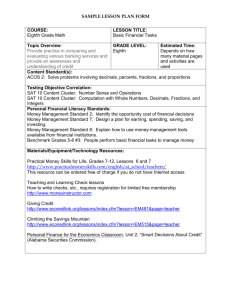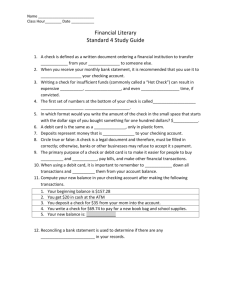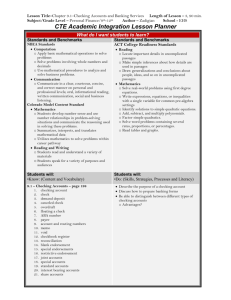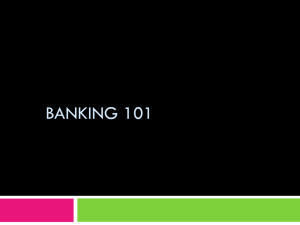BE DVD ROM 29.1 - Banks: A User's Guide
advertisement
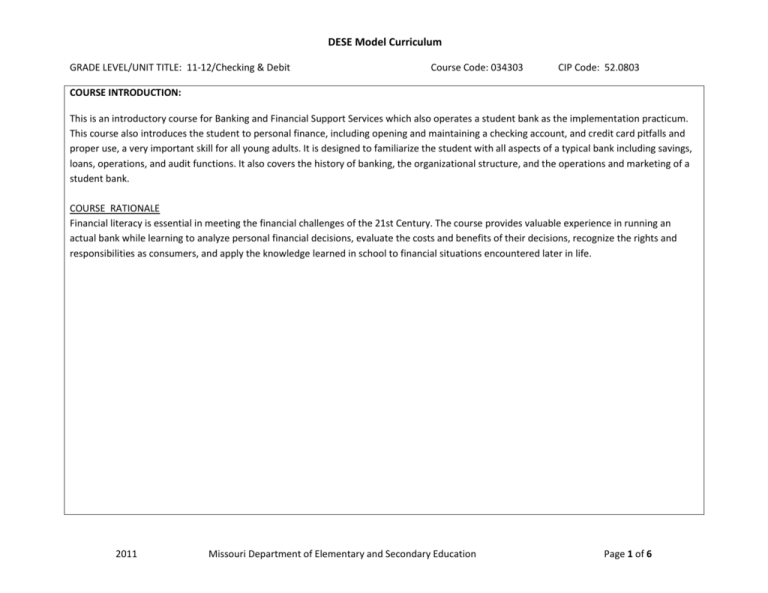
DESE Model Curriculum GRADE LEVEL/UNIT TITLE: 11-12/Checking & Debit Course Code: 034303 CIP Code: 52.0803 COURSE INTRODUCTION: This is an introductory course for Banking and Financial Support Services which also operates a student bank as the implementation practicum. This course also introduces the student to personal finance, including opening and maintaining a checking account, and credit card pitfalls and proper use, a very important skill for all young adults. It is designed to familiarize the student with all aspects of a typical bank including savings, loans, operations, and audit functions. It also covers the history of banking, the organizational structure, and the operations and marketing of a student bank. COURSE RATIONALE Financial literacy is essential in meeting the financial challenges of the 21st Century. The course provides valuable experience in running an actual bank while learning to analyze personal financial decisions, evaluate the costs and benefits of their decisions, recognize the rights and responsibilities as consumers, and apply the knowledge learned in school to financial situations encountered later in life. 2011 Missouri Department of Elementary and Secondary Education Page 1 of 6 DESE Model Curriculum GRADE LEVEL/UNIT TITLE: 11-12/Checking & Debit Course Code: 034303 UNIT 7, DESCRIPTION: Define and explain obligations of the parties for checks and debit draws with the resulting clearing and financial responsibility, endorsement requirements, clearing procedures, statements, dishonored items, fraud by check, identity theft, bank fees CIP Code: 52.0803 SUGGESTED UNIT TIMELINE: 4 weeks CLASS PERIOD (min.): 50 min. ESSENTIAL QUESTIONS: 1. What is a negotiable instrument? 2. In comparing and contrasting the various types of negotiable instruments, what elements of checking and notes dictate a reliable and secure method of payment? 3. How do you detect check fraud, note fraud, and internet commerce fraud? ESSENTIAL MEASURABLE LEARNING OBJECTIVES CCSS LEARNING GOALS (Anchor Standards/Clusters) CROSSWALK TO STANDARDS GLEs/CLEs PS CCSS 1. Define and understand the terminology related to payable items. RI.11-12.4 RI.11-12.7 2. Identify and familiarize with encoding and proofing of payable items and vulnerabilities. RI.11-12.4 RI.11-12.7 3. Identify and familiarize Item capture and sorting. RI.11-12.4 RI.11-12.7 4. Introduce clearing alternatives and the history of payables clearing from Fed check processing and facsimile filing now used. 5. Understand the receipt timing and process by the 2011 Missouri Department of Elementary and Secondary Education OTHER NBEA PF.VI.1 PF.VI.2 PF.VI.3-4 DOK PF.VI.1 PF.VI.2 PF.VI.3-4 PF.VI.1 PF.VI.2 PF.VI.3-4 PF.VI.1 PF.VI.2 PF.VI.3-4 2 PF.VI.1 PF.VI.2 2 Page 2 of 6 2 2 3 DESE Model Curriculum GRADE LEVEL/UNIT TITLE: 11-12/Checking & Debit Course Code: 034303 CIP Code: 52.0803 paying bank. PF.VI.3-4 6. Summarize the Document examination, counterfeit currency and other fraudulent payable items. PF.VI.1 PF.VI.2 PF.VI.3-4 3 7. Elaborate on statements for customers, hidden costs associated with services. PF.VI.1 PF.VI.2 PF.VI.3-4 PF.VI.1 PF.VI.2 PF.VI.3-4 4 PF.VI.1 PF.VI.2 PF.VI.3-4 3 8. Explain the dishonored items process and fee policies often used by banking. Ensure students understand fee avoidance measures. 9. Explain negotiable instruments and differentiate. 4 ASSESSMENT DESCRIPTIONS*: (Write a brief overview here. Identify Formative/Summative. Actual assessments will be accessed by a link to PDF file or Word doc. ) *Attach Unit Summative Assessment, including Scoring Guides/Scoring Keys/Alignment Codes and DOK Levels for all items. Label each assessment according to the unit descriptions above (i.e., Grade Level/Course Title/Course Code, Unit #.) Obj. # INSTRUCTIONAL STRATEGIES (research-based): (Teacher Methods) 1,2,3 1. Teacher led instruction from banking text on specifics of various negotiable instruments. Differentiate between the various types of means of making payment. Use Youtube website to demonstrate the payment process. Explain and demonstrate each informational component part of a check and credit card. 2,6 2. The sponsoring bank will likely have counterfeit currency on occasion that is due to be forwarded to the Fed. Ask the bank to show any counterfeit currency to the class whenever they have any in possession. Demonstrate actions necessary for robbery prevention and mitigation. 1,4,7,8 3. Refer to handout (The Use of an ATM at College - Word file enclosed) Discussion about bank fees and where banks earn revenue in 2011 Missouri Department of Elementary and Secondary Education Page 3 of 6 DESE Model Curriculum GRADE LEVEL/UNIT TITLE: 11-12/Checking & Debit Course Code: 034303 CIP Code: 52.0803 the post 2008 economy where loans are either scarce or government sourced or backed. Obj. # INSTRUCTIONAL ACTIVITIES: (What Students Do) 1,3,6,7 1. Students will research and write about what are Smart Cards and with their convenience, do they pose any security issues? Discuss and debate. 1,2,6 2. Students will use Word, Desktop Publisher, or PPT to create as realistic a check as they can. (example enclosed) They will see that a check created within the class would pass most tests of appearance to the real thing. It will make them aware and wary of accepting checks at glance. 4,5,6,7 3. Students will research the various vulnerabilities of identity theft. Write each on the board and discuss on how to reduce the vulnerability. (cell phone – signal interception, physical theft of info on cell phone, cell phone contacts lead to burglary or bank info compromise, check header should differ from signature, when paying credit card bill, enter only last four digits of number, cross cut shredder instead of spaghetti shredder, database mining for personal info, stored personal information on copier machines, etc.) Cooperative learning opportunity is available –most students know someone who has been the victim of identity theft. Encourage discussion of how to avoid by sharing stories. 2,6 4. Students will be engaged in an exercise with the sponsoring bank on bank robber identification. During a bank visit and orientation, arrange a brief visit by another bank employee who hands a note to the presenter without speaking and leaves. About three minutes later, indicate that the bank has just been robbed by a person who passed a note to this presenter. Ask students to identify this person as clearly as they can. (see attached form: CommercialRobberyIDForm.pdf) Discuss as after action. UNIT RESOURCES: (include internet addresses for linking) See attached files: 8 Things You Should Shred Now, The Use of An ATM At College, Checking Procedures PPT, Crazy Eddie Beginnings, Examples of Fake Check, Identity Theft copiers –video, CommercialRobberyIDForm.pdf Textbook suggestion: Banking & Financial Systems, 2013 by The Goodheart-Willcox Company, Inc.: print 139781605257785 Textbook suggestion: Personal Finance, 2012 by Kapoor, Dlabay, Hughes - McGraw-Hill: print 139780073530697 Textbook suggestion: Banking Systems, 2nd edition 2010, Cengage Learning: eText 139781439028483, print 139780538449281 Textbook suggestion: Banking & Financial Systems, Resources @ MCCE: BE CD ROM 2 - Accounts: From Savings to Checking 2011 Missouri Department of Elementary and Secondary Education Page 4 of 6 DESE Model Curriculum GRADE LEVEL/UNIT TITLE: 11-12/Checking & Debit Course Code: 034303 CIP Code: 52.0803 Meridian Education Corporation LAWRENCEVILLE, NJ, MERIDIAN EDUCATION CORPORATION, 2002. CD ROM — More than ever, people want convenience and flexibility in how they buy things and make payments - and a profit on their deposits, too. This CD-ROM guides users through the ins and outs of savings and checking accounts, the starting place for anyone interested in getting money from MAC machines, paying bills by mail, and making profits on bank-sponsored investments... Windows/Mac BE DVD ROM 29.1 - Banks: A User's Guide Learning Seed CHICAGO IL, LEARNING SEED, 2006. DVD ROM — This program helps viewers understand the basic principles of banking and teaches the basic skills needed to manage money: both the "why" and the "how". From the origins of money and banking, through the basics of checking, savings, and lending, viewers learn about the core functions of a bank, and how these fundamentals affect their daily lives. More than just numbers, the flow of money from depositor to bank to borrower and back again is clearly illustrated. Also covered; debit cards, EFT, online banking, and ATMs. 25 minutes. BE DVD ROM 29.3 - Checking Accounts and Everyday Banking-Personal Finance Essentials: Financial Literacy for Young Earners Meridian Production NEW YORK, NY, MERIDIAN PRODUCTION, 2011. DVD ROM — This program schools viewers in the basics of financial transactions, then arms them with how-to’s and tips for choosing a bank, writing and depositing checks, using a debit card, and balancing a checkbook. E-banking to manage accounts and transfer funds is discussed, with security concerns foremost. The program also explains wire transfers and money orders, and advises on changing money and using travelers checks when abroad. Includes the pros and cons of ATMs, hidden fees associated with checking accounts, and buying and using gift cards. 32 minutes. BE VIDEO 115 - Tools For Financial Success United Learning EVANSTON, IL, DISCOVERY EDUCATION, 2004. VIDEO — This program introduces a number of simple tools that anyone can use to improve his or her financial position. Participants will see the importance of having financial goals and keeping good records. Basic financial tools such as checking accounts, bank accounts, and credit are addressed. Grades 9 - Adult. 23 minutes. Closed captioned. FCS DVD ROM 51 - 21st Century Money Management: Checking Accounts C. W. Publications STERLING, IL, C.W. PUBLICATIONS, 2005. 2011 Missouri Department of Elementary and Secondary Education Page 5 of 6 DESE Model Curriculum GRADE LEVEL/UNIT TITLE: 11-12/Checking & Debit Course Code: 034303 CIP Code: 52.0803 DVD ROM — One of a series of five DVDs packed with information about banking in the new millennium. Not only are the basics of opening and maintaining accounts covered, but these DVDs also teach viewers how to manage their money successfully. Special focus is given to online banking functions and resources. Series titles include: Checking Accounts; Savings; Credit Cards; Loans; Financial Planning. Grade 7 - Adult. 20 to 25 minutes. BE 13.1303 T171 - Games Accounting Teachers Play Joy Tavano, Editor WARWICKM RI, BUSINESS EDUCATION PUBLISHING, 2006. BOOK — This book includes a collection of games, activities, and strategies--from debits and credits and T-accounts to journalizing entries and the accounting equation. Organized into six accounting instructional categories: Bulletin boards and visual reinforcements; Classroom discussion generators; Accounting games; Hands-on activities; Creative projects and assessments; Accounting teaching tips and resources. 2011 Missouri Department of Elementary and Secondary Education Page 6 of 6




